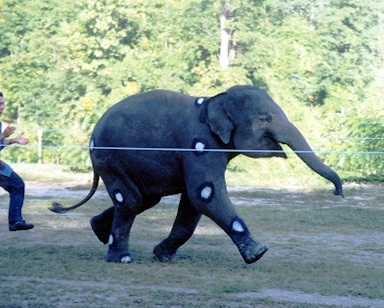Elephants are able to walk as well as run at high speeds: Analysts
 Animal researchers have said that Elephants can walk as well as run at high speeds. Usually when elephants are in high speed, they appear to be walking.
Animal researchers have said that Elephants can walk as well as run at high speeds. Usually when elephants are in high speed, they appear to be walking.
John Hutchinson from the Royal Veterinary College, UK studied elephant footfall patterns closely and found that the giant animal's front legs walk while their rear legs may run. Norman Heglund from the Universite catholique de Louvain, Belgium looked at the forces exerted on the animals by the ground to find out more. He built calibrate, an 8m long platform from sixteen 1m2 force plates. The research included 34 elephants which ranged from an 870kg baby to a four tonne adult
"We had to build the plates as you just can't go down to your local hardware shop and pick up an elephant-sized force plate," said Professor Heglund.
The fastest elephant reached 18km per hour. Their movements were recorded by using high speed cameras. On the basis of the observation, the animal's movements were extremely economical. The observers studied the centre of the mass of the elephants.
Elephants consume only a third of the cost of transport of humans at 0.8J/kg/m. This is due to the reason that the animal's step frequency is higher and they improve their stability by keeping an average of two feet on the ground even at high speeds. They keep three feet on the ground at lower speed.
These movement patterns cause the elephant's centre of mass to bounce less and hence it consumes less energy.
The professor explained, "The running gait, in most animals, is a bouncing mechanism. In this case, the potential and kinetic energy are in phase, they both hit a maximum at the same time and a minimum at the same time, so they cannot be transferred back and forth."
The research then focused on finding out the way that each animal recycles potential energy into kinetic energy. The researchers could determine if the animals run or walk by observing how elephants change potential energy into kinetic energy.
The observation of the relationship between potential and kinetic energy is the key to defining whether something is walking or running.
By studying the potential and kinetic energy of the elephants' centres of mass at different speeds the researchers were able to determine that the elephants were walking at low speeds and as their speed increased the kinetic and potential energy plots shifted to look like those of runners.
On the other hand, the Elephants were able to shift their weight from one side to the other but also bobbed down and up like a runner.
In conclusion, the elephants appear to walk on one basis while another view is that their front legs walk while their hind legs run at high speeds. The research confirms that elephants do both.